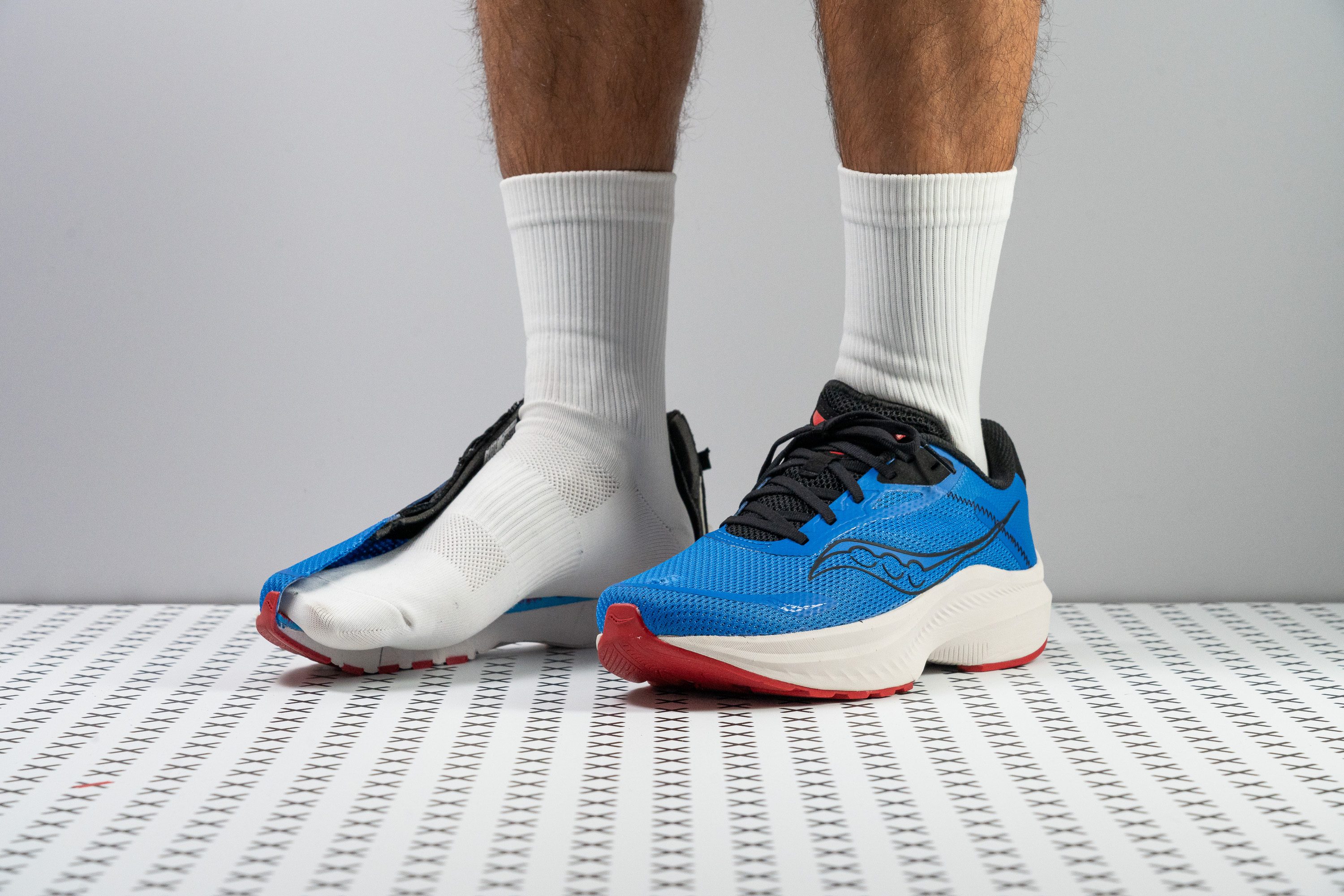Our verdict
- Top pick in best running shoes for beginners (2024)
- Top pick in best low drop running shoes (2024)
Pros
- Incredible value at only $100
- Significant weight reduction from version 2
- Impressively cushioned with PWRRUN foam
- Fantastic durability
- Suitable for quicker paces
- Excellent as a daily workhorse
- Lovely upper
- Works for short and long runs
Cons
- Probably too stiff for very relaxed runs
- Slightly narrower forefoot than before
Audience verdict
- Top 28% in daily running shoes
Comparison
The most similar running shoes compared
+ + Add a shoe | |||||
|---|---|---|---|---|---|
| Audience score | 89 Great! | 85 Good! | 92 Superb! | 88 Great! | |
| Price | $100 | $140 | $125 | $90 | |
| Pace | Daily runningTempo | Daily running | Daily running | Daily running | |
| Shock absorption | - | Moderate | High | Moderate | |
| Energy return | - | Low | Moderate | Low | |
| Traction | - | Moderate | Moderate | High | |
| Arch support | Neutral | Neutral | Neutral | Neutral | |
| Weight lab Weight brand | 8.6 oz / 244g 8.5 oz / 241g | 10.5 oz / 298g 11.1 oz / 314g | 10.1 oz / 285g 9.7 oz / 275g | 9.2 oz / 261g 9.3 oz / 263g | |
| Lightweight | ✓ | ✗ | ✗ | ✗ | |
| Drop lab Drop brand | 5.7 mm 4.0 mm | 5.2 mm 5.0 mm | 6.5 mm 6.0 mm | 6.0 mm 6.0 mm | |
| Strike pattern | Mid/forefoot | Mid/forefoot | Mid/forefoot | Mid/forefoot | |
| Size | True to size | True to size | True to size | True to size | |
| Midsole softness | Soft | Balanced | Soft | Balanced | |
| Difference in midsole softness in cold | Small | Normal | Normal | Small | |
| Toebox durability | Decent | Decent | Decent | Bad | |
| Heel padding durability | Good | Good | Bad | Decent | |
| Outsole durability | Good | Good | Good | Good | |
| Breathability | Moderate | Moderate | Moderate | Breathable | |
| Width / fit | Medium | Narrow | Narrow | Medium | |
| Toebox width | Medium | Narrow | Medium | Medium | |
| Stiffness | Stiff | Stiff | Moderate | Stiff | |
| Torsional rigidity | Stiff | Moderate | Stiff | Stiff | |
| Heel counter stiffness | Moderate | Stiff | Moderate | Moderate | |
| Rocker | ✓ | ✗ | ✓ | ✗ | |
| Heel lab Heel brand | 33.6 mm 35.0 mm | 33.2 mm 30.0 mm | 34.1 mm 38.0 mm | 32.7 mm 29.0 mm | |
| Forefoot lab Forefoot brand | 27.9 mm 31.0 mm | 28.0 mm 25.0 mm | 27.6 mm 32.0 mm | 26.7 mm 23.0 mm | |
| Widths available | Normal | Normal | Normal | Normal | |
| Orthotic friendly | ✓ | ✓ | ✓ | ✓ | |
| Season | All seasons | All seasons | All seasons | SummerAll seasons | |
| Removable insole | ✓ | ✓ | ✓ | ✓ | |
| Ranking | #116 Top 32% | #225 Bottom 39% | #7 Top 2% | #134 Top 37% | |
| Popularity | #294 Bottom 20% | #43 Top 12% | #268 Bottom 27% | #273 Bottom 26% |
Who should buy
We believe the Saucony Axon 3 is an excellent choice for:
- Any runner seeking a shoe that's easy on the wallet and offers plenty of cushioning and comfort.
- Beginners in the sport keen to find one of the best bang-for-the-buck shoes in the market.
- Those that seek a durable trainer, especially for midfoot and forefoot strikers, as it has a lower drop than usual.

Who should NOT buy
If you're an extreme heel striker, the Axon might not be the best fit, given its low-drop geometry. You'd be better off with the Nike Winflo 10, which offers a higher offset while maintaining many of the Axon's features, including its affordability.
Additionally, the Axon 3 caters more to those with wider feet and may not be suitable for runners with narrow feet. In that's you, we recommend opting for a narrower option like the Brooks Trace 2, which should provide a better fit for your wider foot shape.
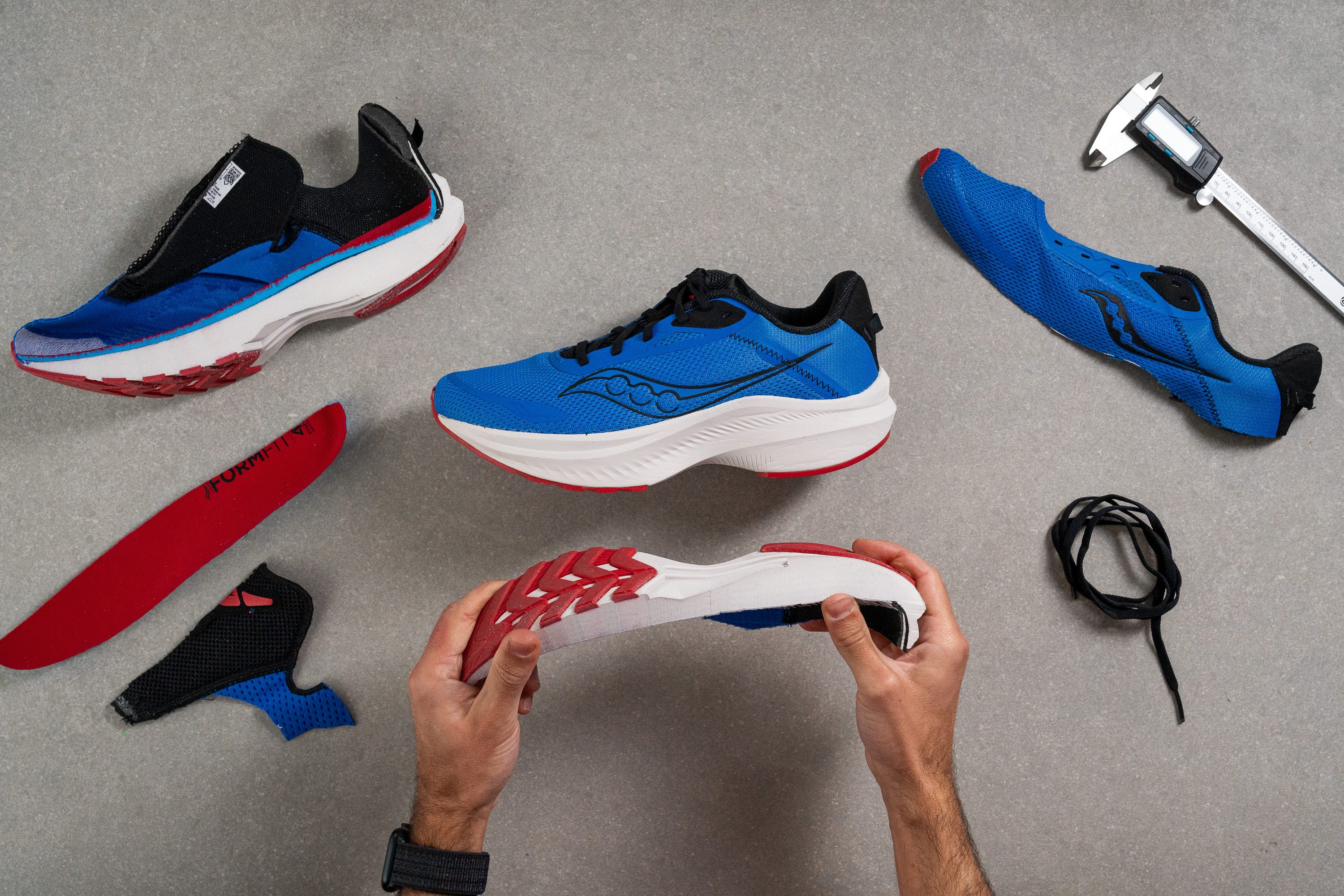
Cushioning
Heel stack
In the heel, there's a substantial stack height of 33.6 mm. However, it doesn't feel like a max-stacked, maximalist shoe. It's more akin to a really cushioned daily trainer, which everyone seems happy with, as it remains consistent with last year's version.
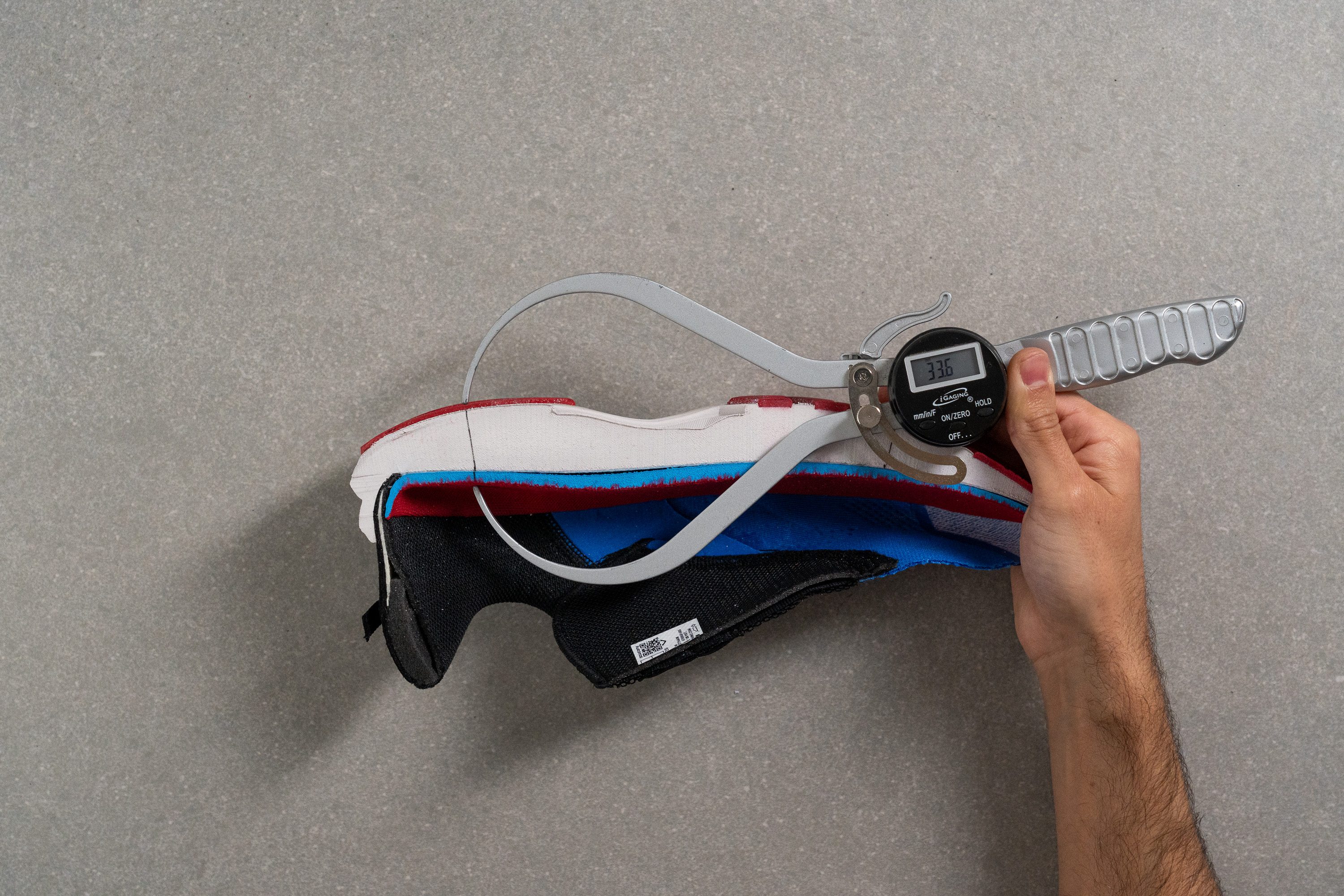
| Axon 3 | 33.6 mm |
| Average | 34.8 mm |
Forefoot stack
In the forefoot, we measured 27.9 mm, which is also above what most daily trainers offer and quite surprising, given the shoe's low weight. We're still amazed at how Saucony managed to create a shoe this cushioned and affordable for just $100.
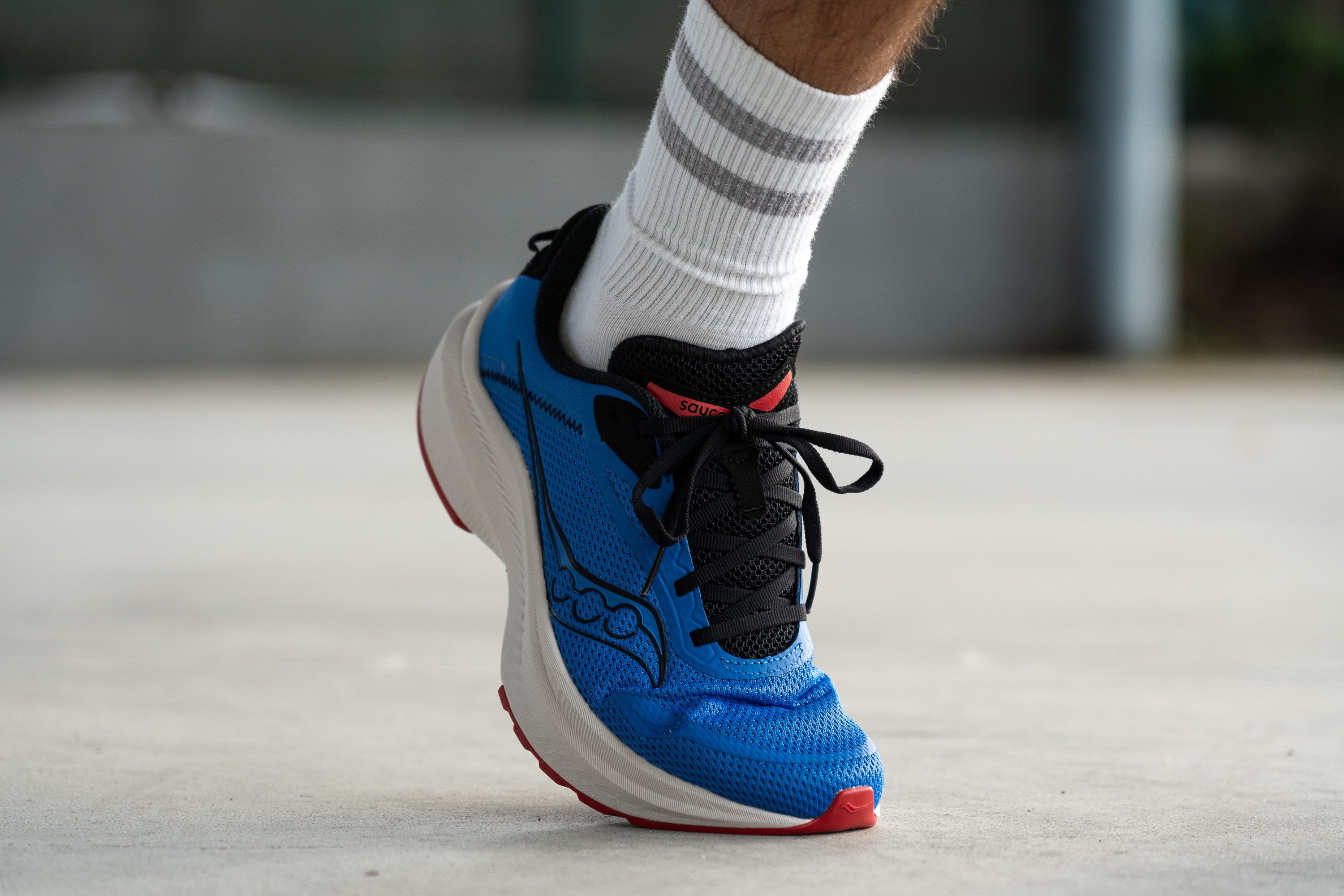
With such a generous stack in the forefoot area, those who use a forefoot striking technique are well accommodated with the Axon 3. This is particularly important, considering the shoe's low-drop geometry.
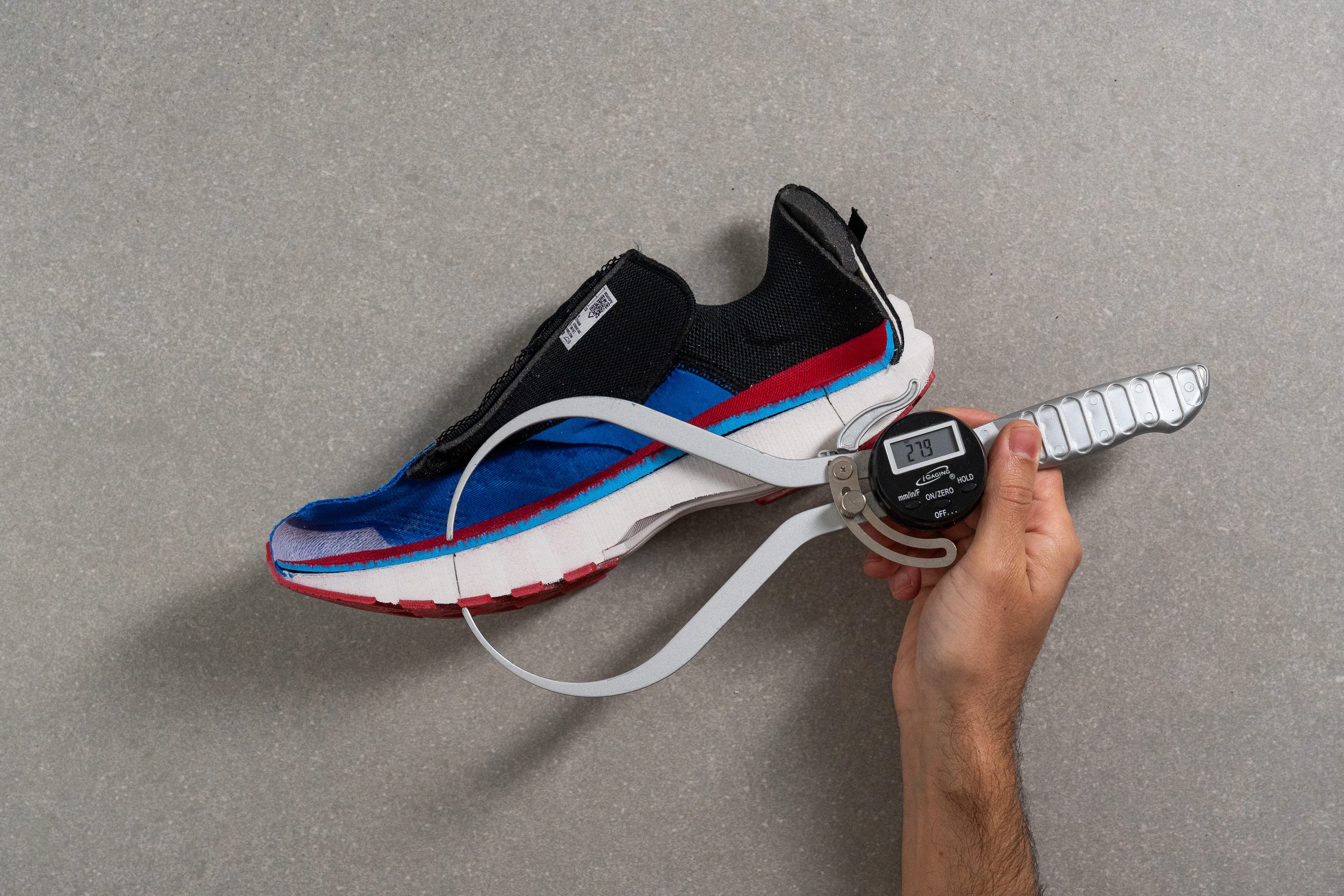
| Axon 3 | 27.9 mm |
| Average | 26.2 mm |
Drop
We mentioned just before that this shoe leans toward a low-drop geometry, although it's higher than Saucony's stated figure.
They claim a 4-mm offset, but according to World Athletics standards, we measured it at 5.7 mm. Regardless, this isn't a big deal, and the shoe still feels like it has a lower drop compared to other models and it's ideal for those who favor less steep shoes.
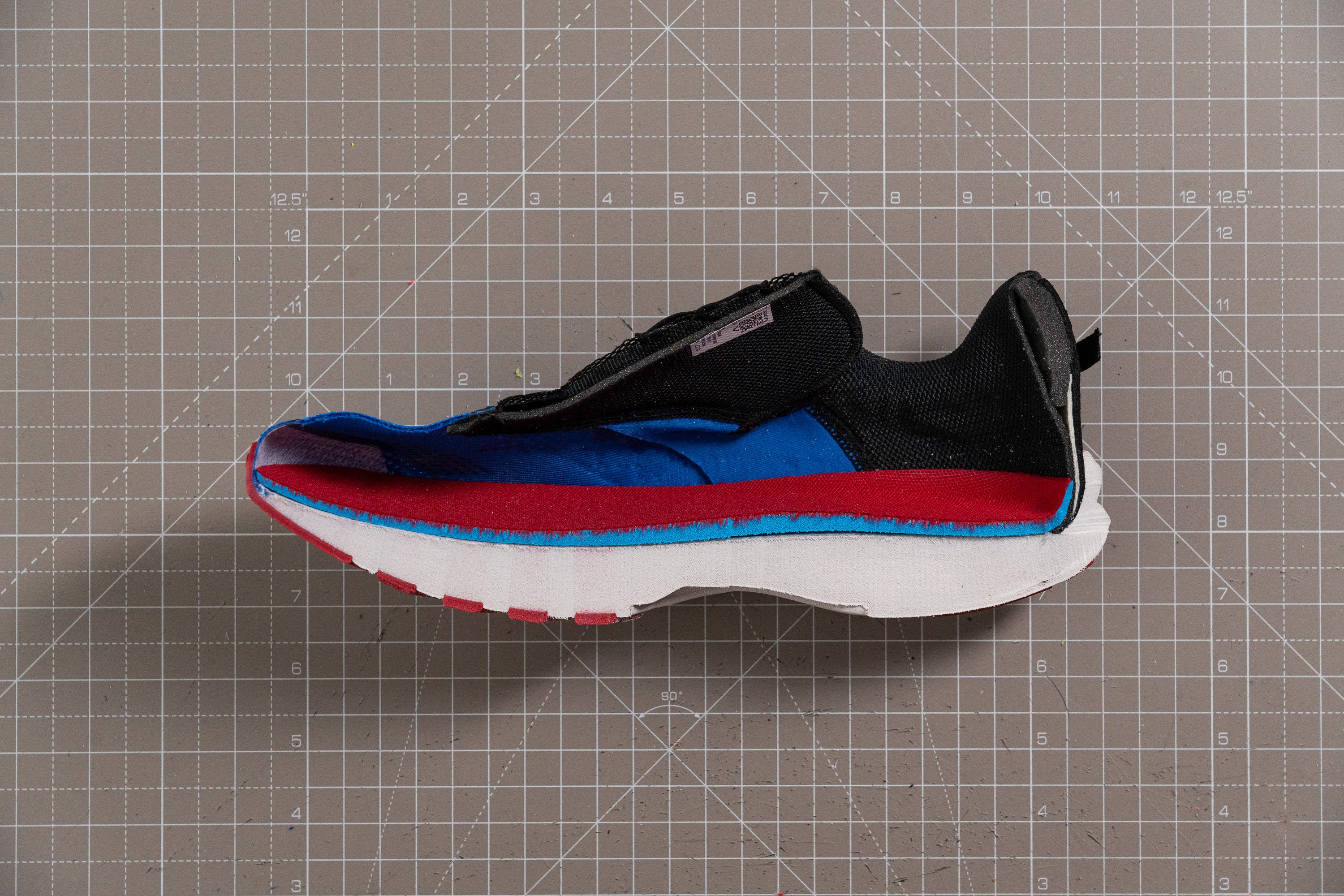
| Axon 3 | 5.7 mm |
| Average | 8.6 mm |
Midsole softness
The trend in running shoe foams leans towards becoming softer each year, and the Axon 3 follows suit.
After assessing the PWRRUN foam with our Durometer, we recorded a softness of 18.3 HA, making it 22% softer than the Axon 2.
In our tests, the midsole felt definitively softer and more plush, marking another step forward in its evolution.
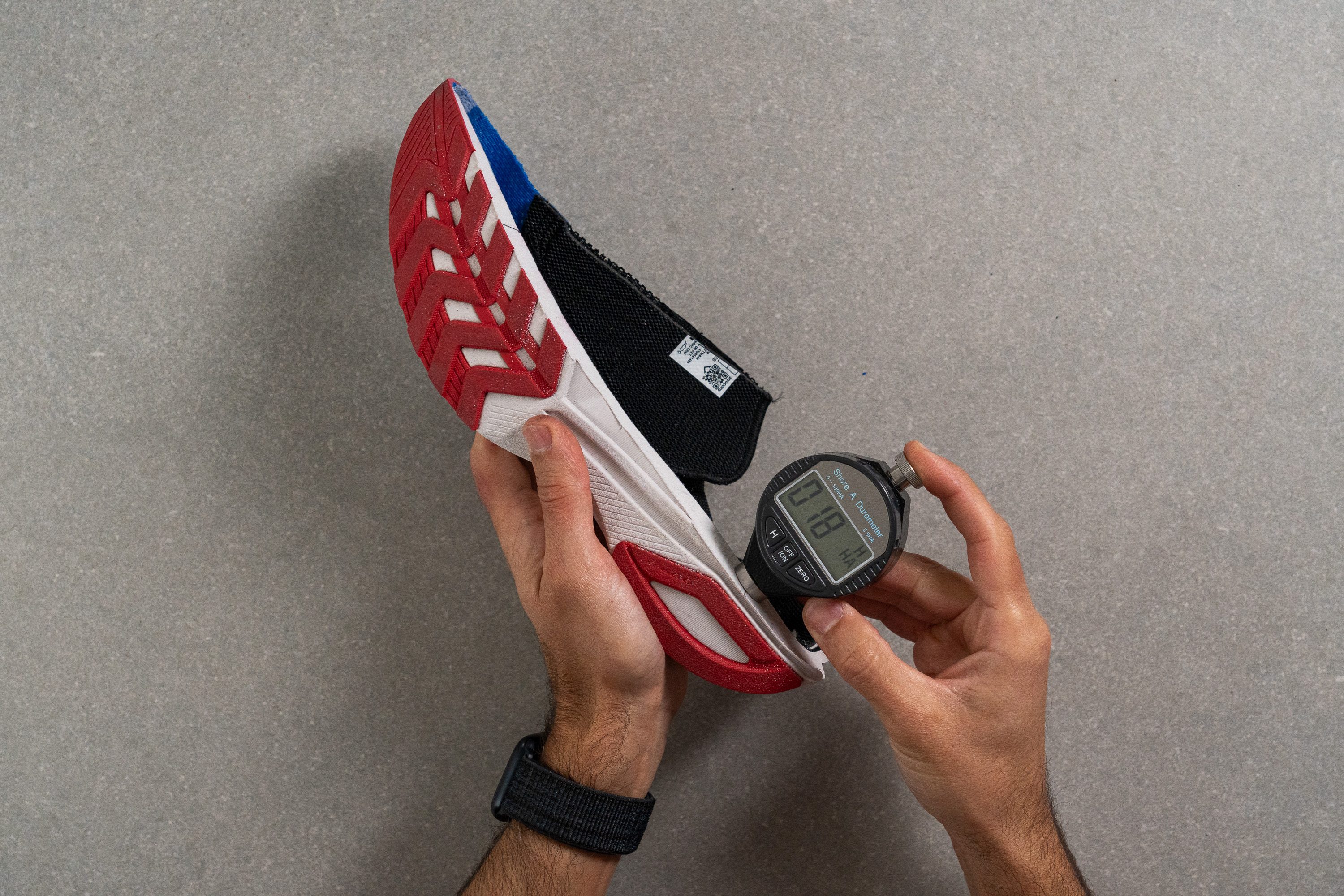
| Axon 3 | 18.3 HA |
| Average | 20.4 HA |
Size and fit
Size
Saucony Axon 3 fits true to size (35 votes).
Width / Fit
In the widest part of the shoe, we measured a generous 97.4 mm. This makes Axon 3 particularly suitable for those with wide feet.
This wider upper is especially crucial since Saucony doesn't produce this shoe in a 2E width, leaving the standard width as the only option.
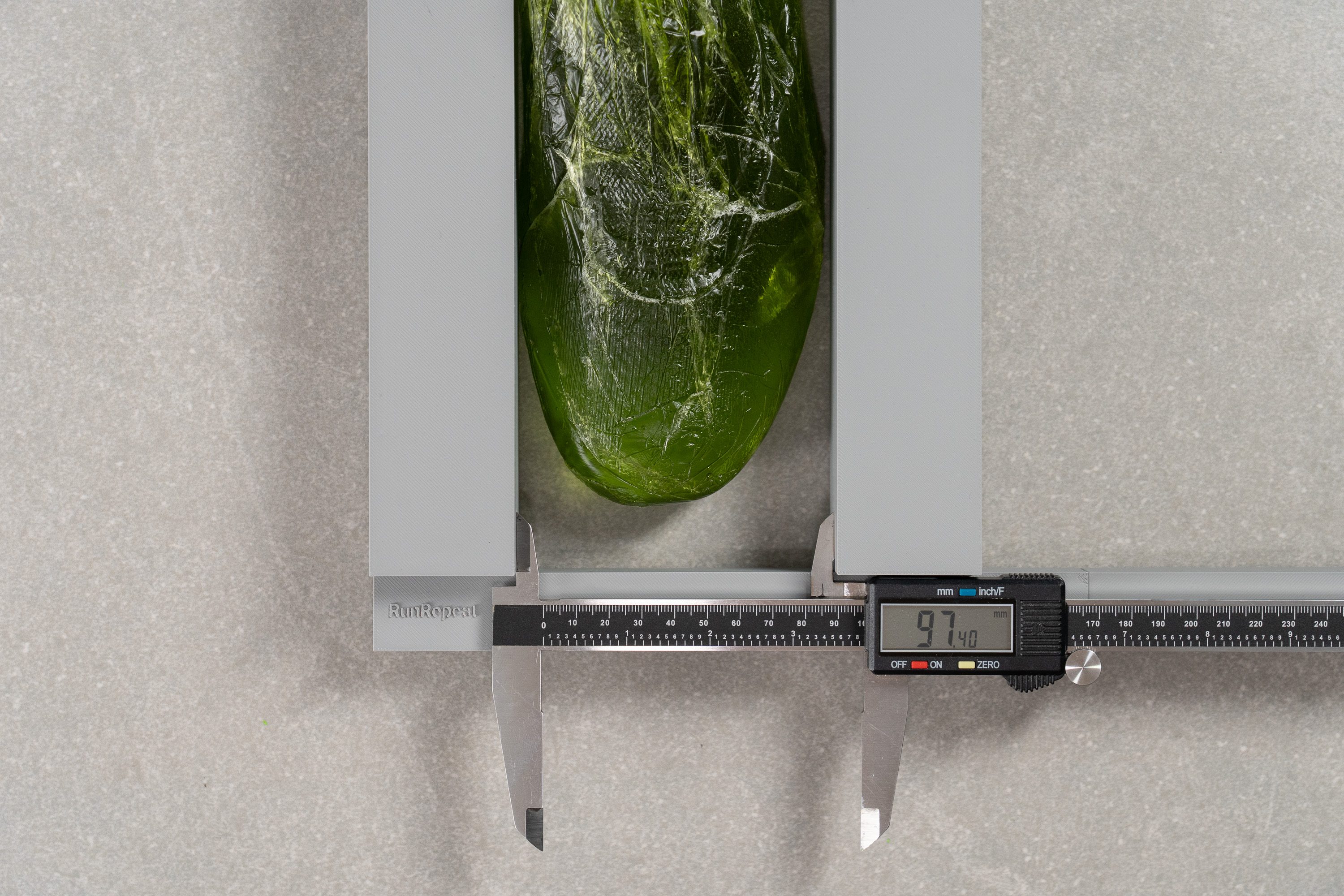
| Axon 3 | 97.4 mm |
| Average | 95.1 mm |
Toebox width
One significant drawback of the Axon 2 was its tapered toebox, which caused discomfort for many runners, particularly in the big toe area. While the Axon 3 hasn’t fully reached the average at just 71.8 mm, it’s making progress!
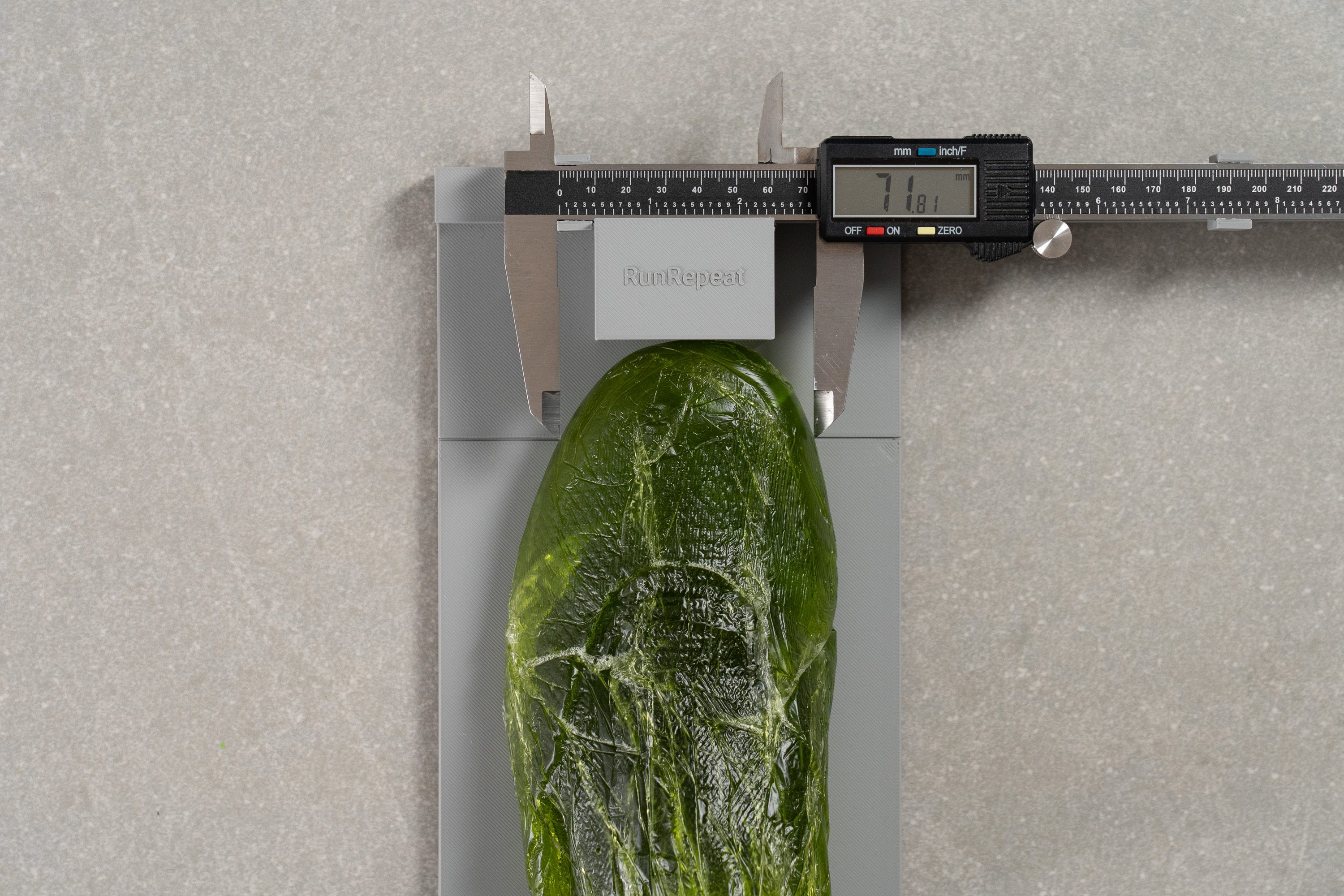
| Axon 3 | 71.8 mm |
| Average | 73.3 mm |
Toebox height
In terms of height, we measured 29.1 mm—a standout result for runners who dislike toe pressure and another compelling reason the Axon 3 is an excellent budget-friendly choice for longer distances.
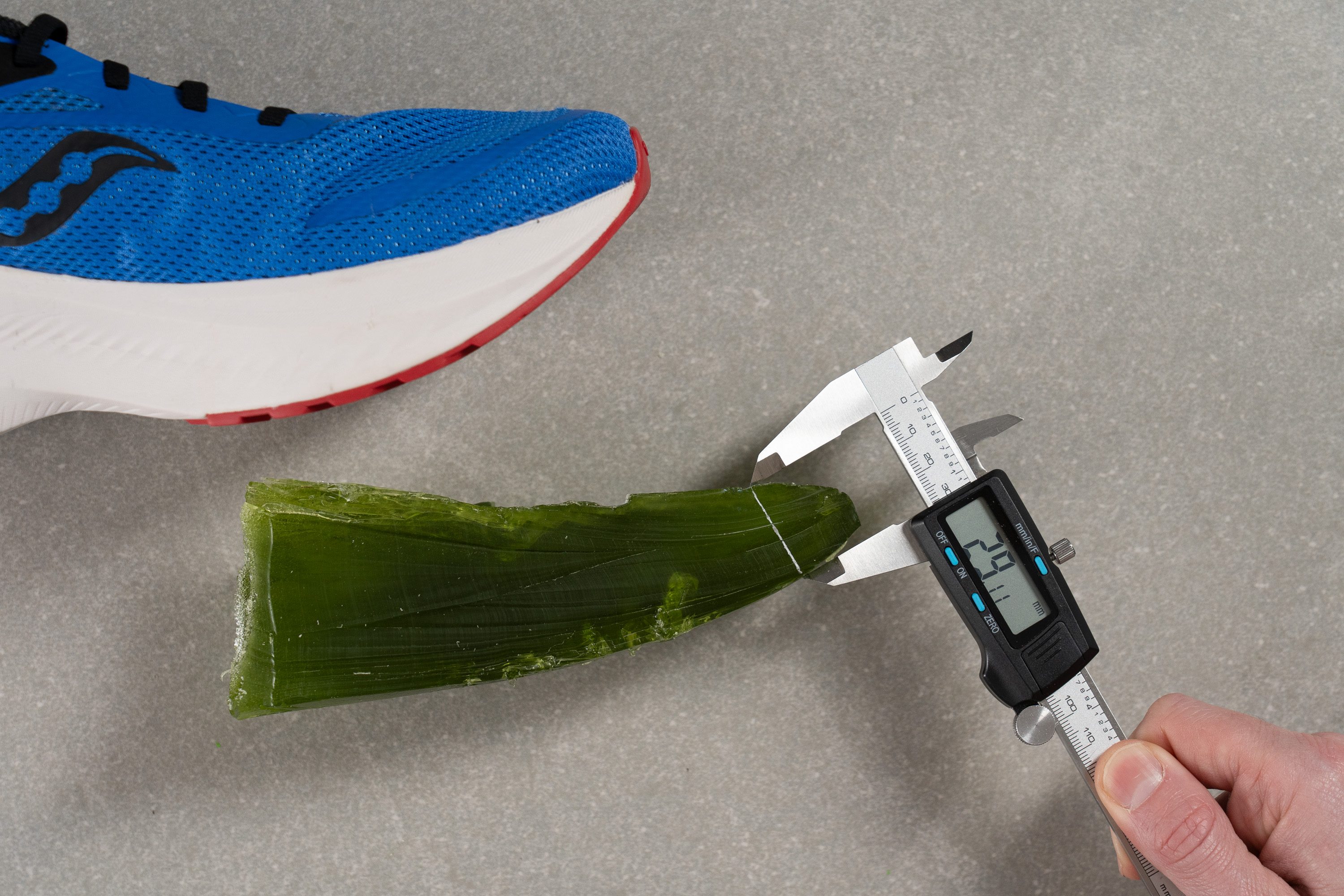
| Axon 3 | 29.1 mm |
| Average | 27.1 mm |
Flexibility / Stiffness
Another concern with the Axon 2 was its incredible stiffness. In fact, in our 90-degree bend test, we had to apply 39.9N of force, whereas this year's model required only 30.4N.
This result aligns more with our expectations for this kind of shoe, but the Axon 3 still tends toward being stiff, both torsionally and longitudinally, as our lab tests have demonstrated.
This test follows an older methodology, which is why you don't see recently tested shoes in the chart. Results from different methodologies can not be compared.
| Axon 3 | 30.4N |
| Average | 28.1N |
Stiffness in cold (%)
We conducted the 20-minute freezer test again to gauge the shoe's stiffness in harsh winter conditions. After the test, we found a need to make 17.6% more force to bend the shoe. This subtle change highlights once more the solid performance of the PWRRUN compound, even under challenging winter conditions.
| Axon 3 | 18% |
| Average | 33% |
Weight
Most budget-friendly running shoes tip the scales at well over 10 ounces, as brands typically use cheaper, heavier materials.
Saucony, however, took the exact opposite approach and crafted the ultimate lightweight, wallet-friendly shoe, weighing in at just 8.6 oz (244g). Oh, and let's not overlook this—it's 1.3 oz lighter than the Axon 2. Now that's what we'd call going on a proper diet...
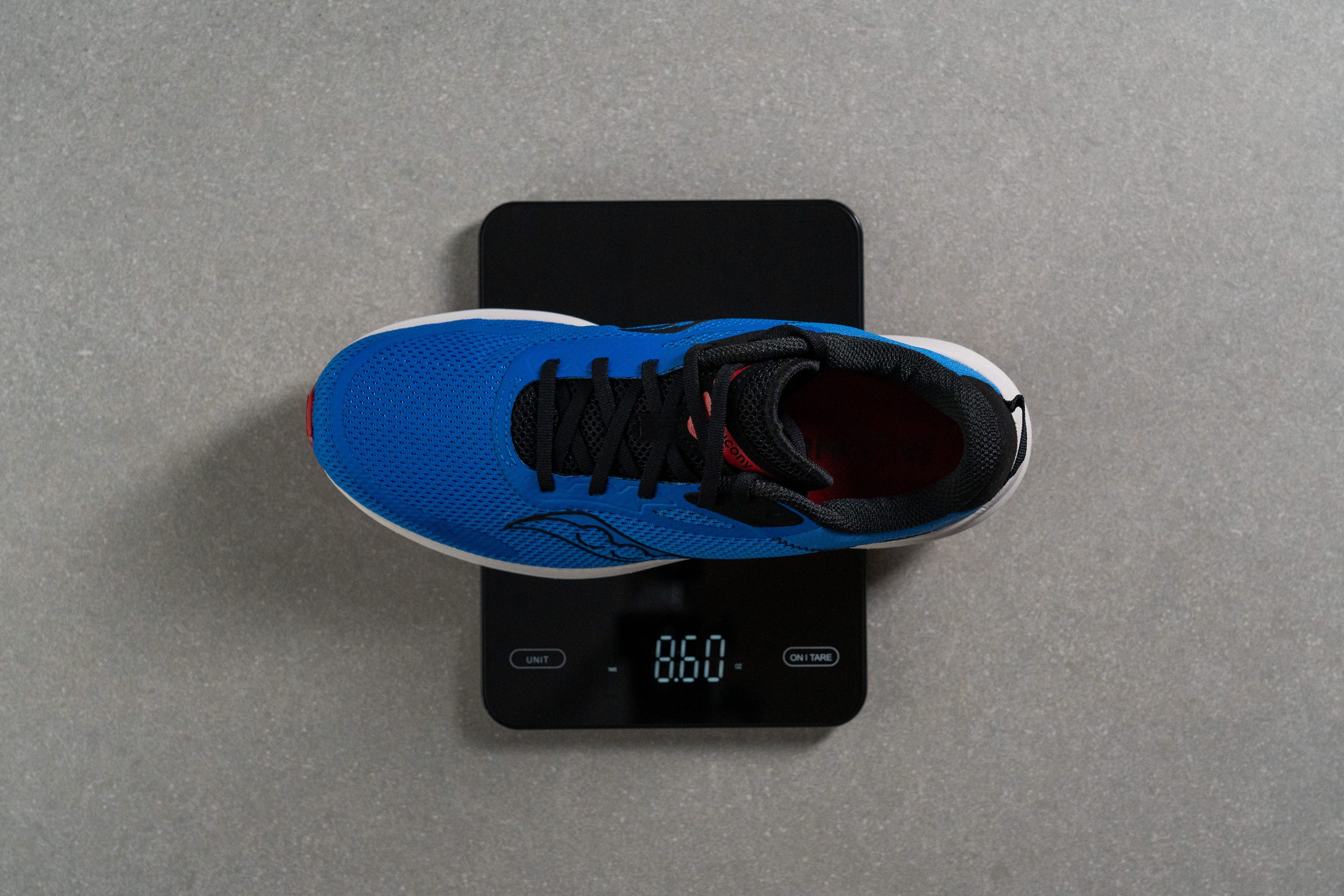
| Axon 3 | 8.6 oz (244g) |
| Average | 9.3 oz (264g) |
Breathability
Right off the bat, the Axon 3 seemed to have everything needed for optimal breathability—a perforated, thin engineered mesh free from obstructive, TPU overlays. We were eager to see how it would perform in our smoke test.
As expected, it did quite well. While it didn't earn the max score, a 4 out of 5 is still an impressive result for a budget-friendly shoe. And this is especially great for winter use, where top-notch breathability isn't always a plus.
When we placed the cut-in-half shoe under the light, it revealed hundreds of ventilation holes, not just in the toebox. The upper resembled that of a premium shoe in its precision and quality.
To examine the mesh even more closely, we headed to our microscope in the lab.
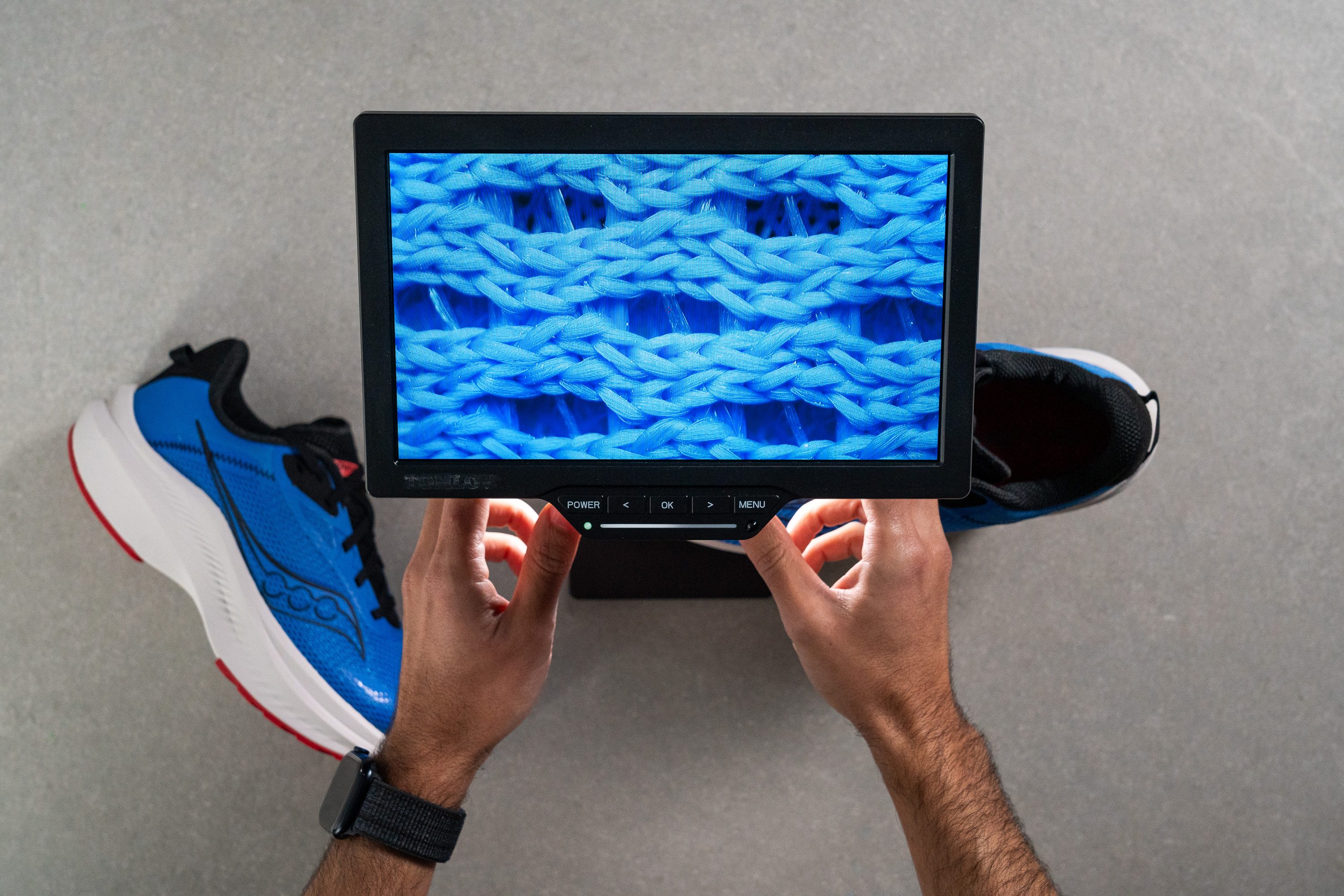
Under the microscope, the upper looked stunning, featuring a double-layer mesh that masterfully balances comfort with ventilation.
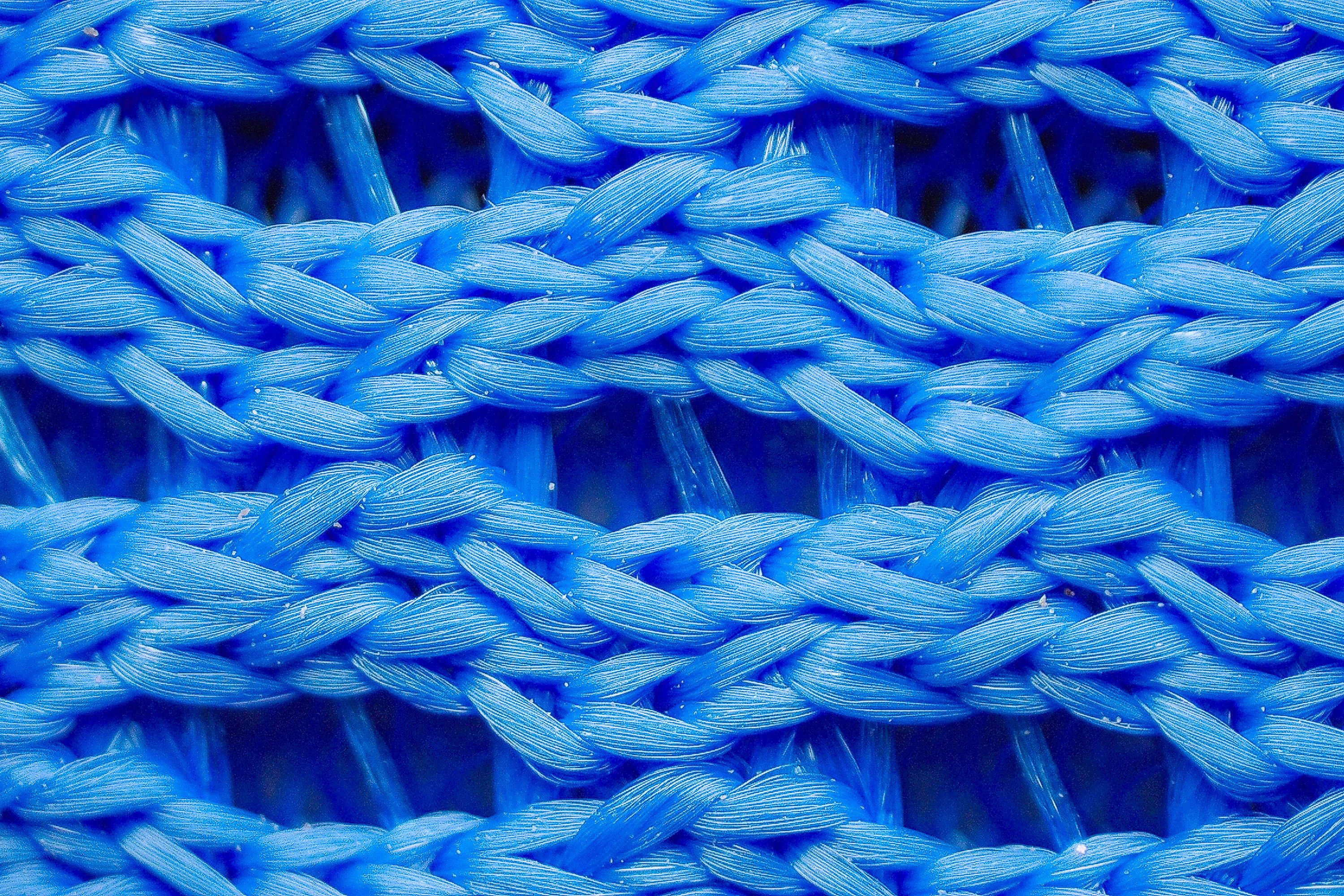
In our final manual assessment of the upper, we noted it's not as padded and stretchy as some other shoes, but we never felt discomfort. However, this is something to keep in mind if you prefer knitted, Ultraboost-like uppers.
| Axon 3 | 4 |
| Average | 3.7 |
Stability
Lateral stability test
Now, let's talk about stability. There's no way around it—the shoe, although still reasonably stable for its height, can't be considered as stable as its predecessor because of the softer foam.
Torsional rigidity
Since it's very similar to the previous model, we expected the Axon to be quite rigid, as has been consistent with this line.
We found it scored 4 out of 5 for rigidity. Therefore, we think runners who prefer a more flexible, natural ride should consider other options, like the Brooks Launch 10.
| Axon 3 | 4 |
| Average | 3.5 |
Heel counter stiffness
In the heel counter, there are subtle changes aimed at reducing stiffness, which was previously uncomfortable for some runners, resembling a stability trainer rather than a daily running shoe.
This time we've clocked it at 3 out of 5 for stiffness, striking a good balance. We found it to be really comfortable, a notable improvement that enhances the overall running experience especially when tackling long runs.
| Axon 3 | 3 |
| Average | 2.9 |
Midsole width - forefoot
Shifting to the midsole's dimensions, we measured the forefoot at just 108.8 mm, narrower than what we typically see in the lab.
This design choice aligns with the goal of reducing weight, but it could raise concerns for runners with mild stability needs who have a forefoot striking technique.

| Axon 3 | 108.8 mm |
| Average | 114.4 mm |
Midsole width - heel
In the heel, we found exactly the opposite situation—the shoe has grown by 9%, which is significant in this test. In fact, it could now be considered a wide shoe in the heel area, and we have an idea why these changes occurred.
Basically, the Axon 3 is primarily aimed at beginners due to its low MSRP. With a less steep drop than most daily trainers, there's a higher likelihood of runners landing on their heels. So, Saucony widened the heel area—dead simple!

| Axon 3 | 95.7 mm |
| Average | 90.7 mm |
Durability
Toebox durability
With so many ventilation holes, we think durability might be compromised. After all, each hole is a potential ripping point. But a lot depends on the strength of the mesh.
Luckily, the engineered mesh Saucony uses is quite tough based on our Dremel test. So, despite the numerous holes, it managed to score an average 2 out of 5 for durability.
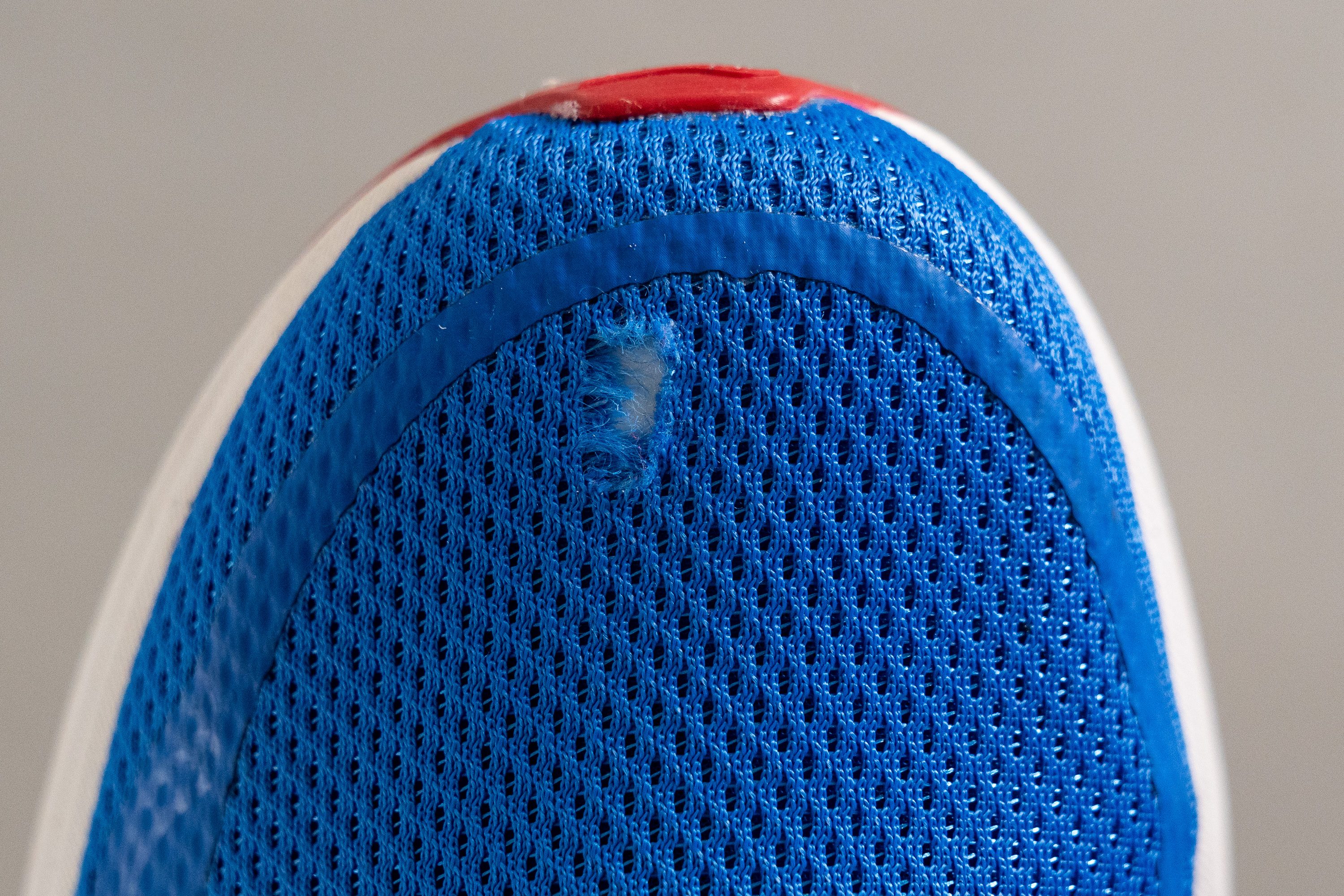
| Axon 3 | 2 |
| Average | 2.6 |
Heel padding durability
The heel area boasts a rougher fabric, which, on paper, suggests enhanced durability and a reduced risk of heel slippage, as it firmly holds the feet in place.
Moreover, after conducting our Dremel test, we found barely any damage, earning it an outstanding maximum score of 5 out of 5 for durability!
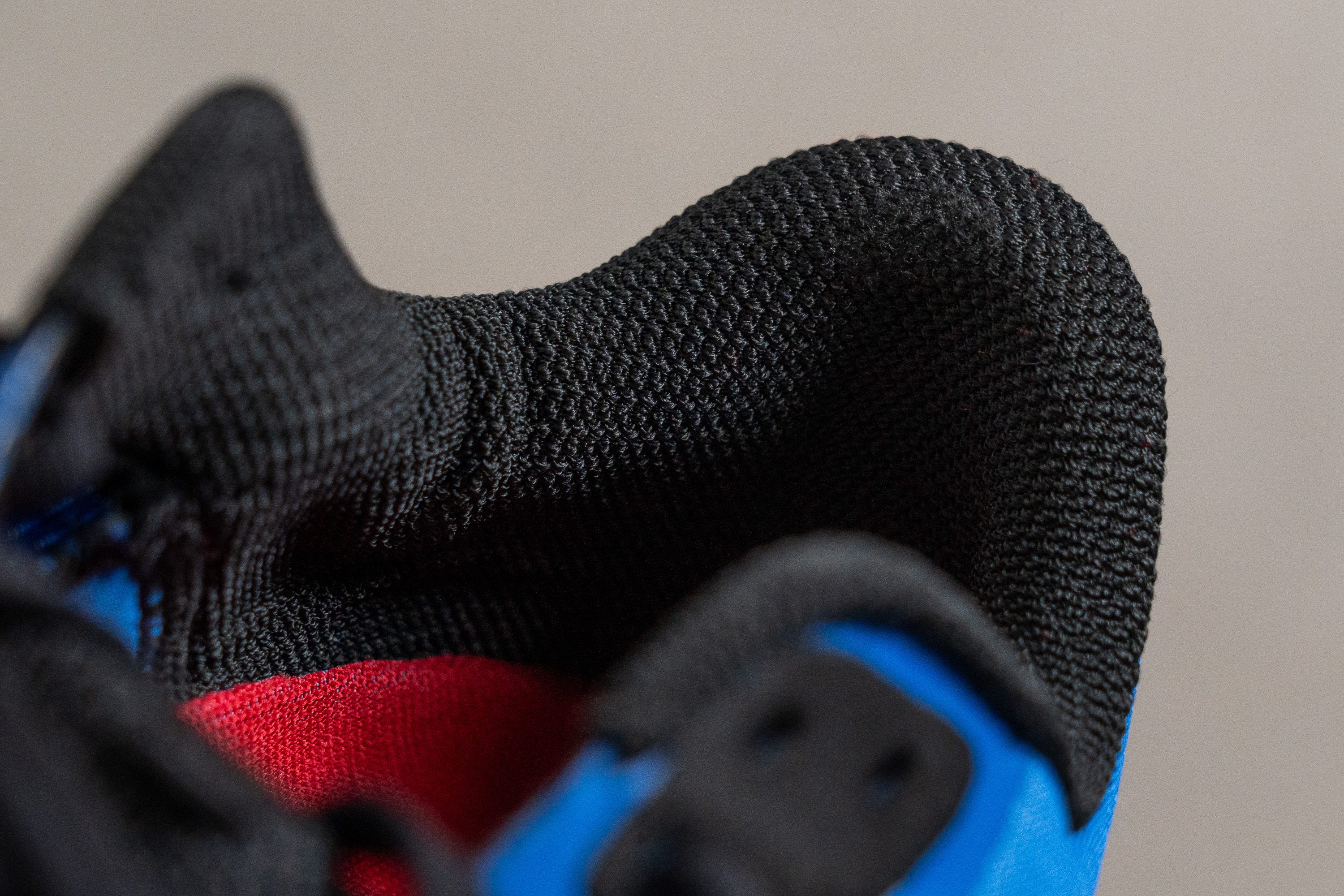
| Axon 3 | 5 |
| Average | 3.4 |
Outsole hardness
Encouraged by the last positive result, we were eager to test the outsole. Our first step was to determine the hardness value of the Carbon Rubber outsole.

Measuring 82.5 HC on our Shore C durometer, it earned a standard score—exactly what you'd anticipate in a daily trainer. This represents a balanced mix of durability and grip, aligning well with the shoe's overall performance.
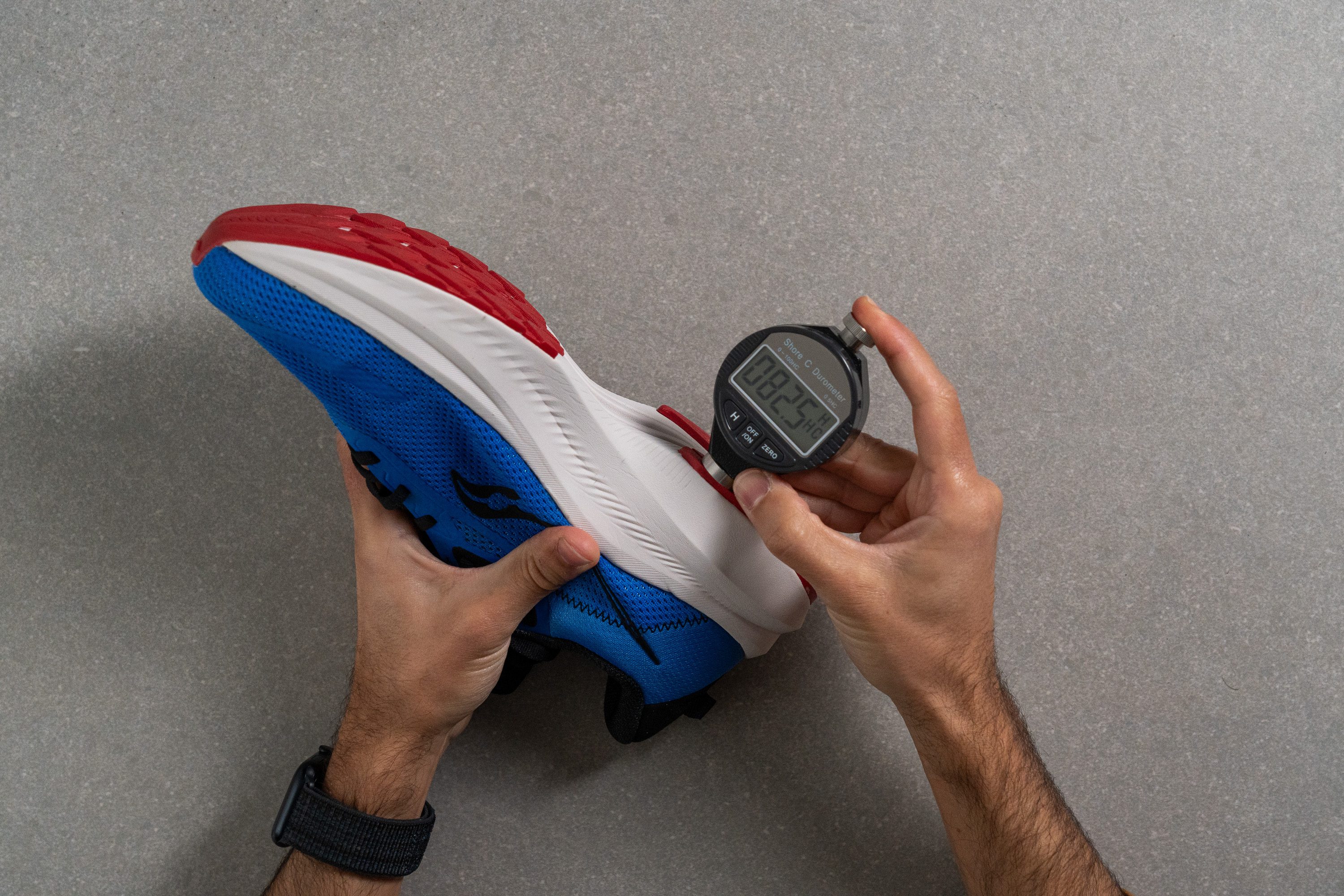
| Axon 3 | 82.8 HC |
| Average | 79.2 HC |
Outsole durability
Given the outsole's average hardness, we anticipated typical durability from our final Dremel test.
What we discovered in the lab didn't disappoint us at all—a mere 0.7-mm indentation. This result assures solid performance in terms of wear and tear, even if you frequently run on gravel paths or dirt roads.
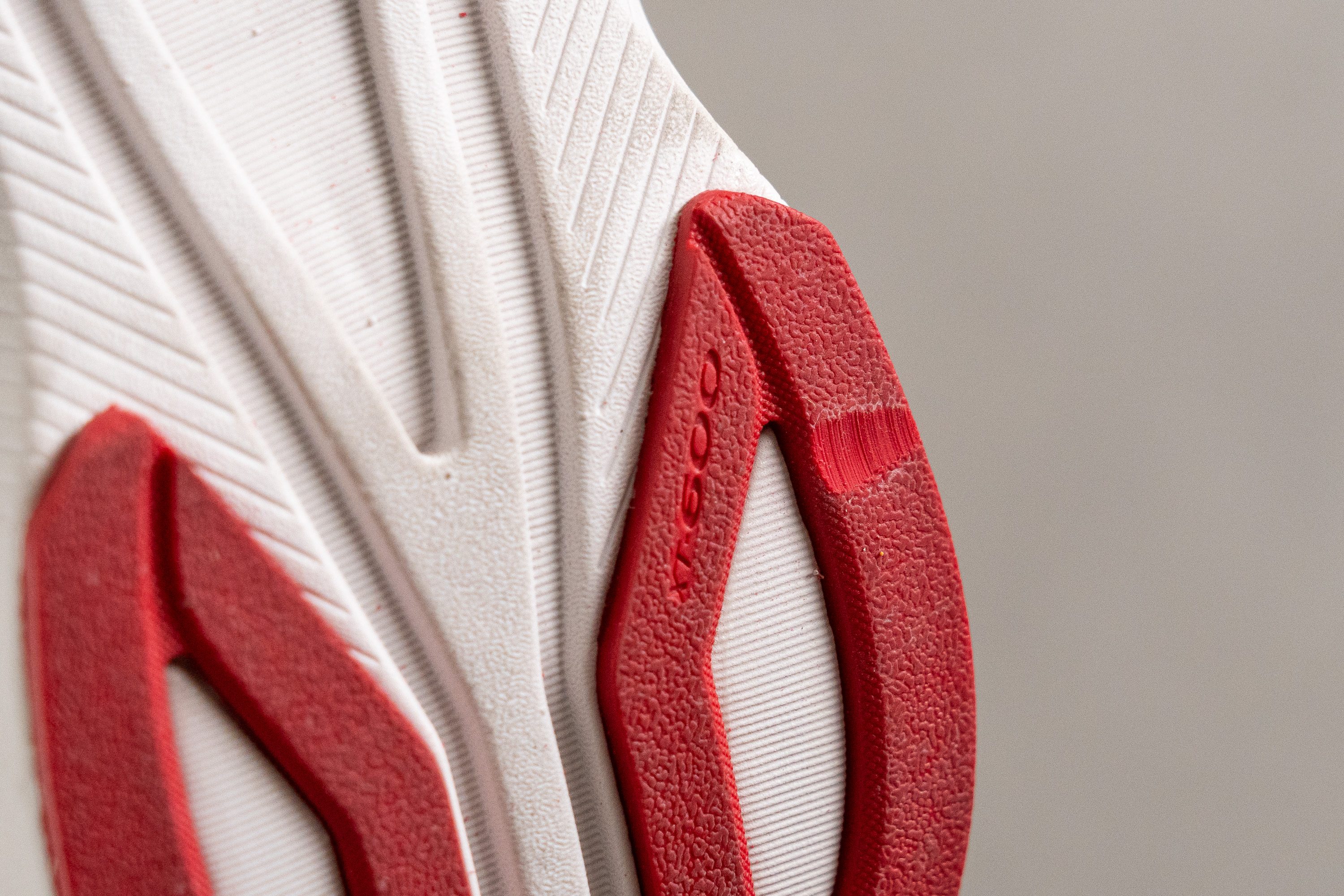
| Axon 3 | 0.7 mm |
| Average | 1.1 mm |
Outsole thickness
Adding to the good news, there's even more to be excited about in terms of durability. Despite the shoe feeling incredibly light—we'll weigh it in just a moment—it boasts a substantial rubber thickness of 3.9 mm!
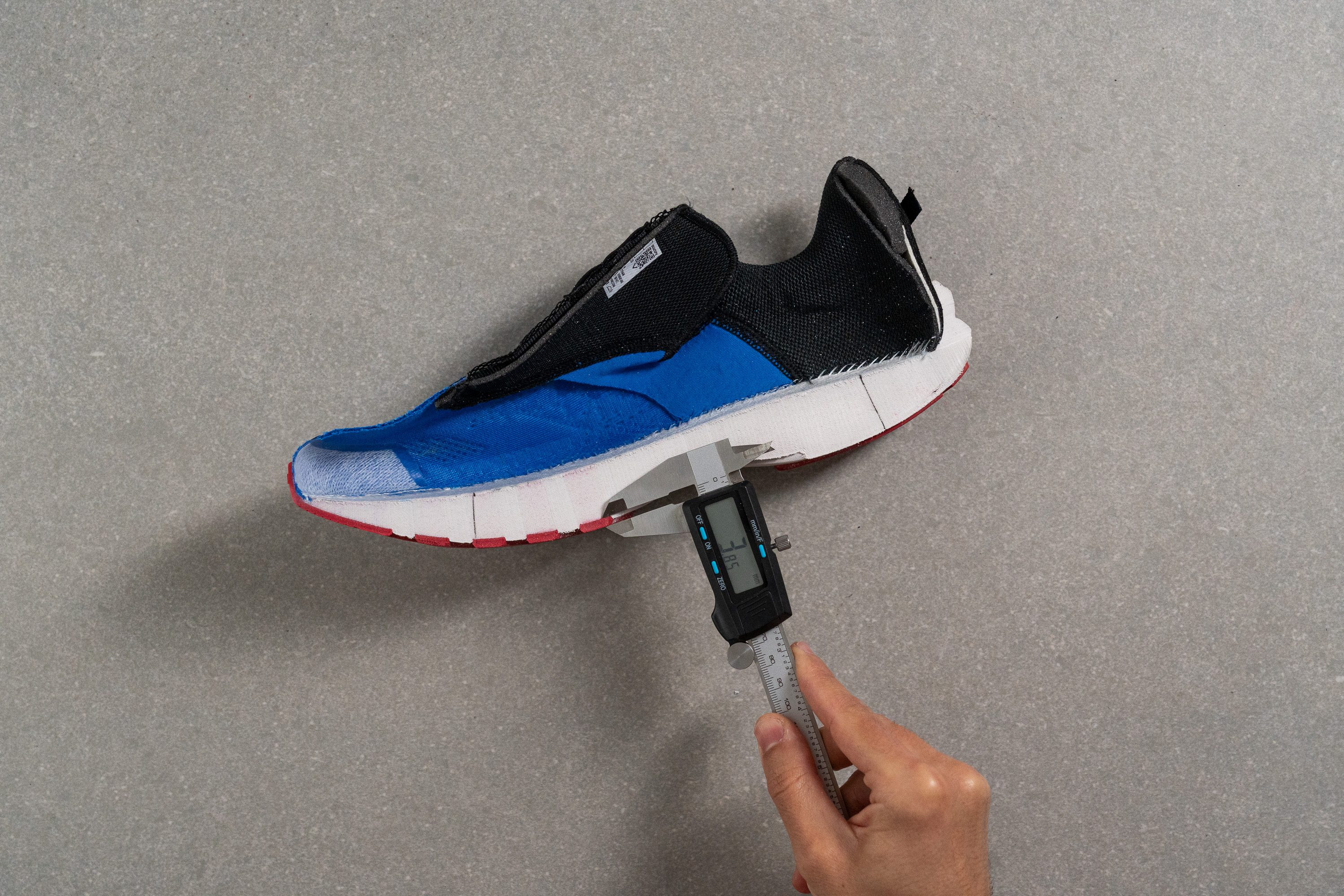
| Axon 3 | 3.9 mm |
| Average | 3.2 mm |
Misc
Insole thickness
The insole is pretty straightforward, and it does its job well. We measured it at 4.7 mm, which is pretty much the standard thickness we find in most shoes.
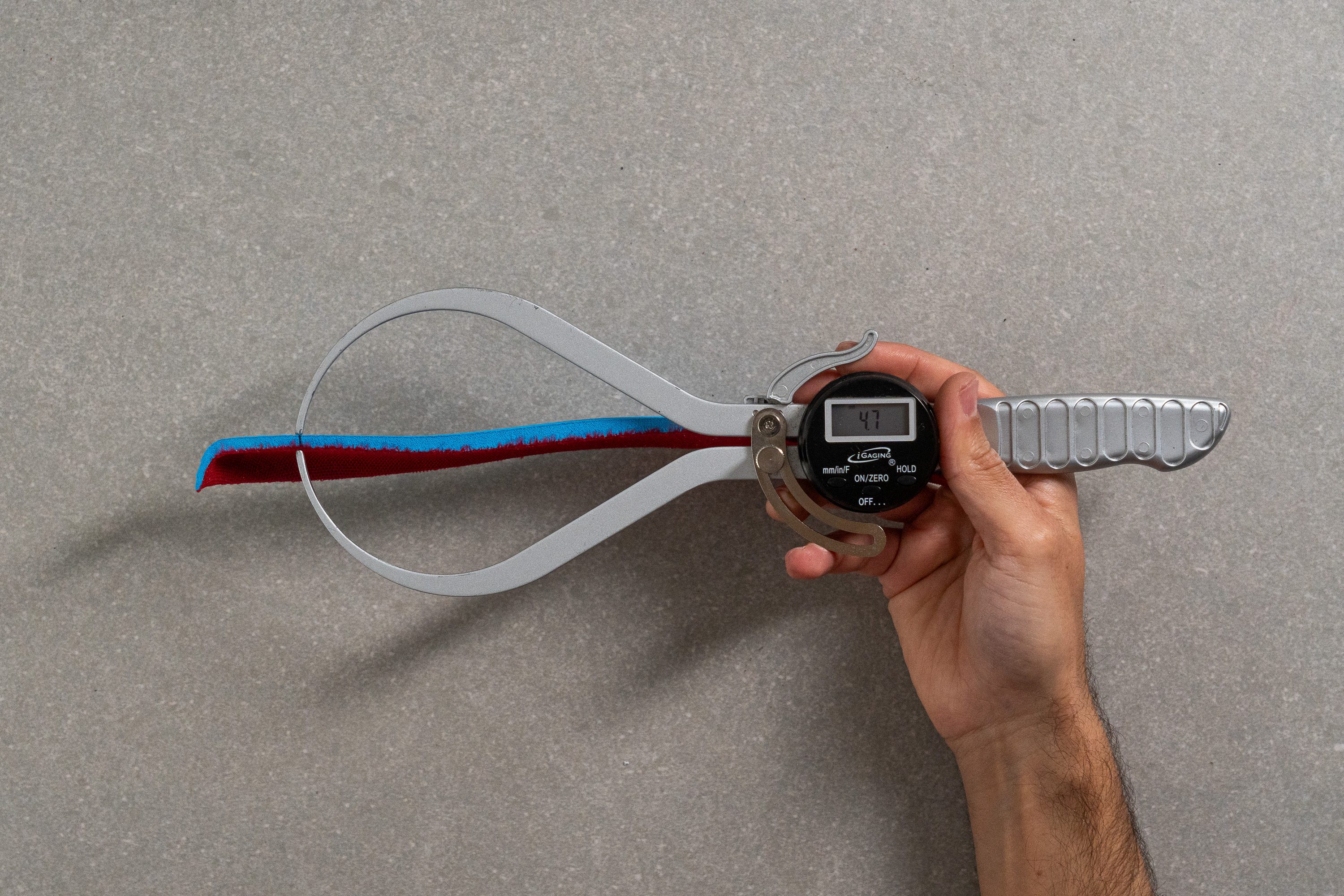
| Axon 3 | 4.7 mm |
| Average | 4.5 mm |
Removable insole
The insole is fully removable since it's not glued in place. As an added bonus, it's printed with the shoe's 4-mm heel-to-toe offset. However, our measurements indicated a different one as we explained before...

| Axon 3 | Yes |
Midsole softness in cold
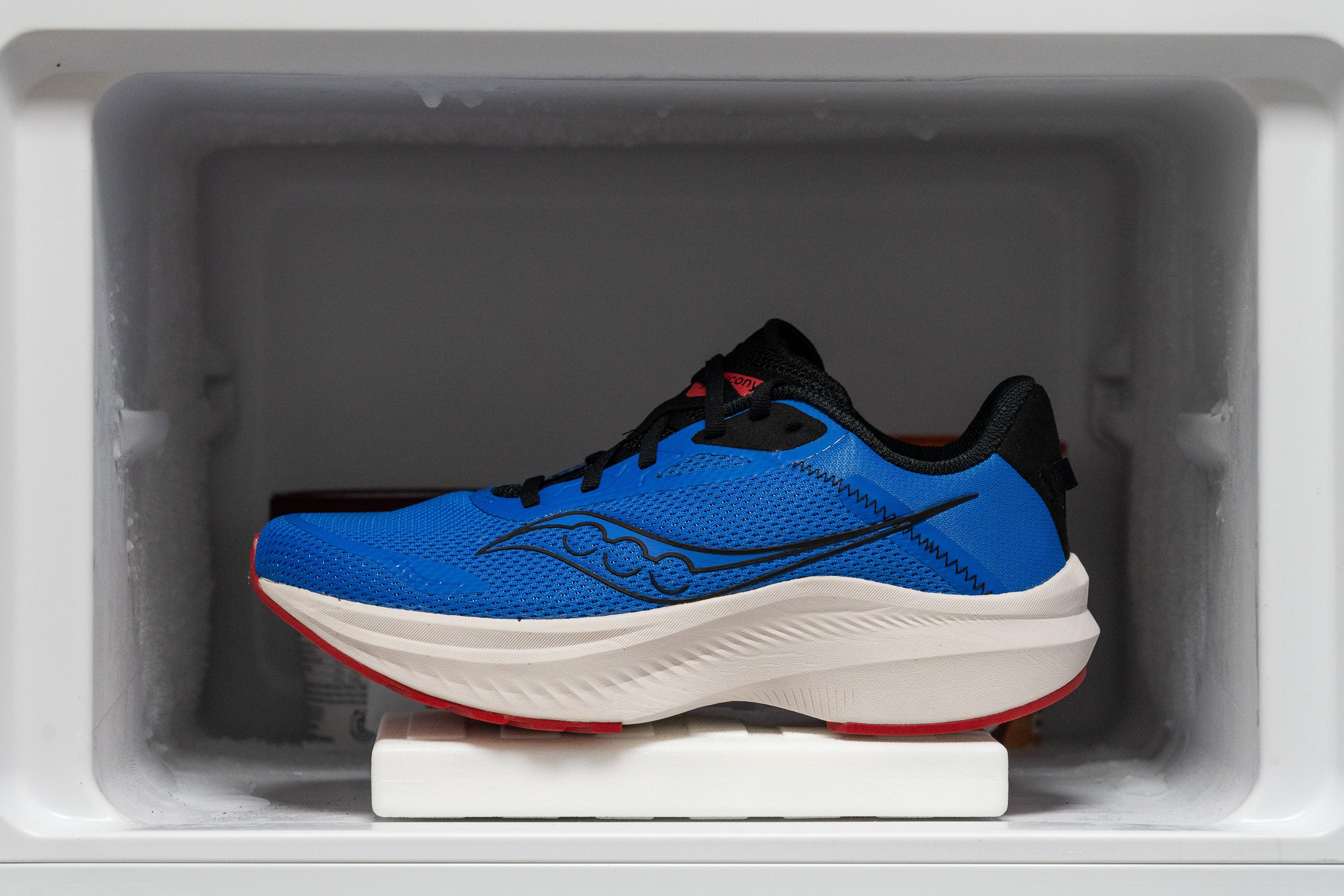
Midsole softness in cold (%)
Under cold temperatures, the PWRRUN midsole remained consistent, showing only a 20.2% change in softness. This difference probably won't be noticeable to most runners.
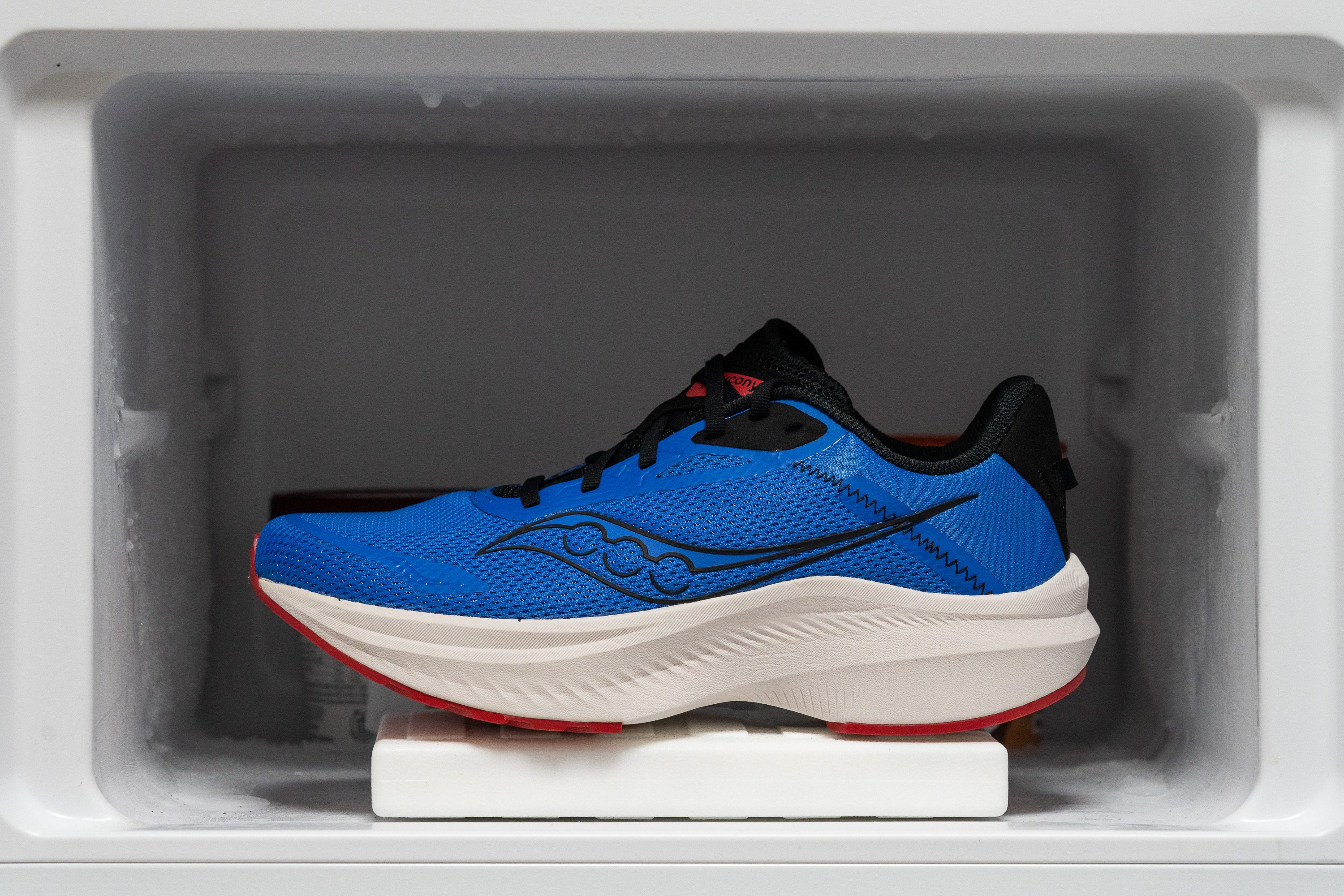
| Axon 3 | 20% |
| Average | 24% |
Reflective elements
For just $100, we got a really good shoe with the Axon 3, so we're okay with Saucony saving reflective elements for their higher-end models. If they have to cut costs somewhere, this is the place.
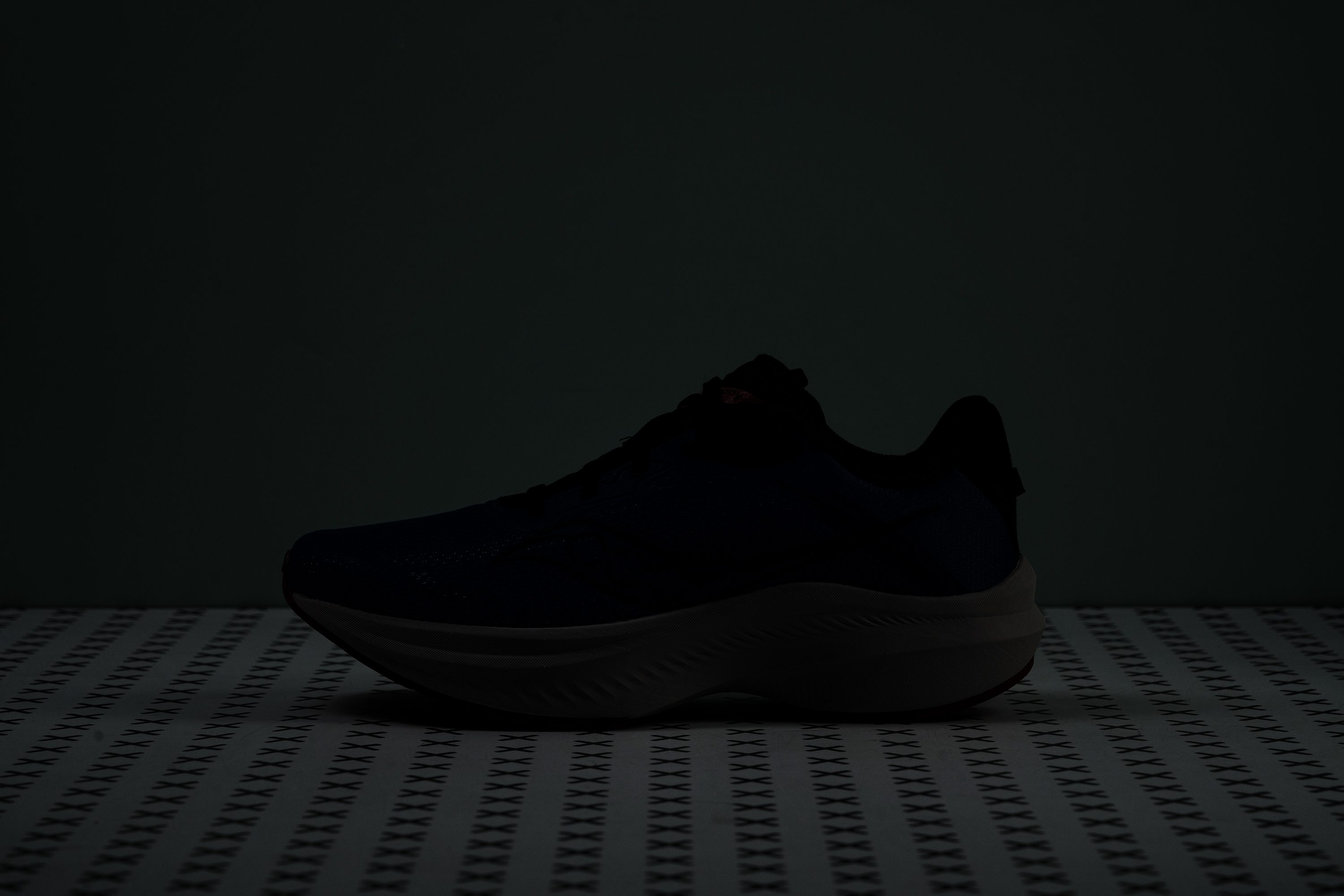
| Axon 3 | No |
Tongue padding
The tongue features average padding at 5.0 mm, which we think is a smart approach. Considering the shoe's signature low weight, opting for thicker padding would have been counterproductive.
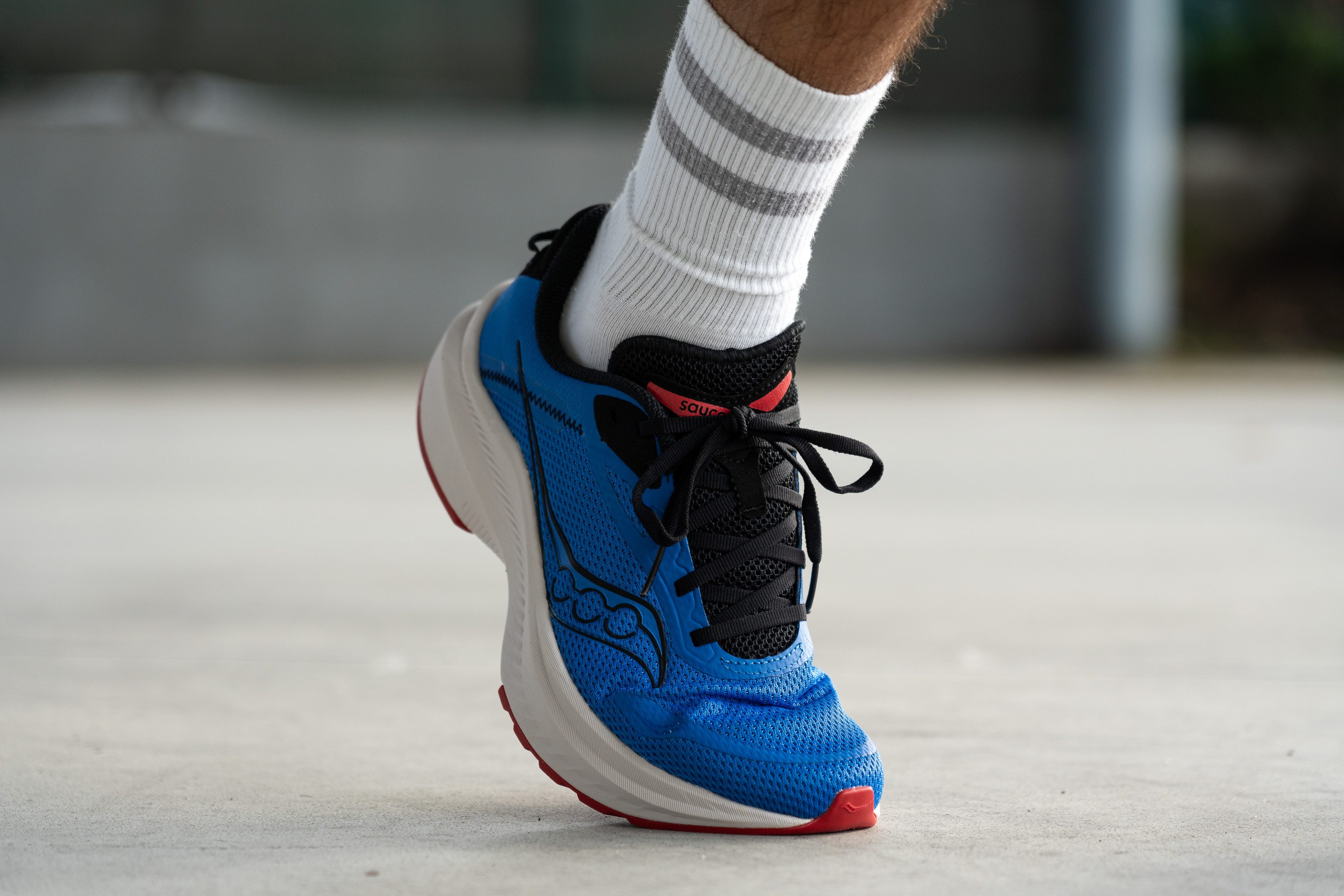
This thoughtful balance adds just enough comfort without compromising the Axon's lightweight appeal.

| Axon 3 | 5.0 mm |
| Average | 5.8 mm |
Tongue: gusset type
For just 100 bucks, you get features often reserved for pricier shoes, and one of them is the semi-gusseted tongue.
It's amazing, offering a solid, comfortable lockdown that's usually found in more expensive models.
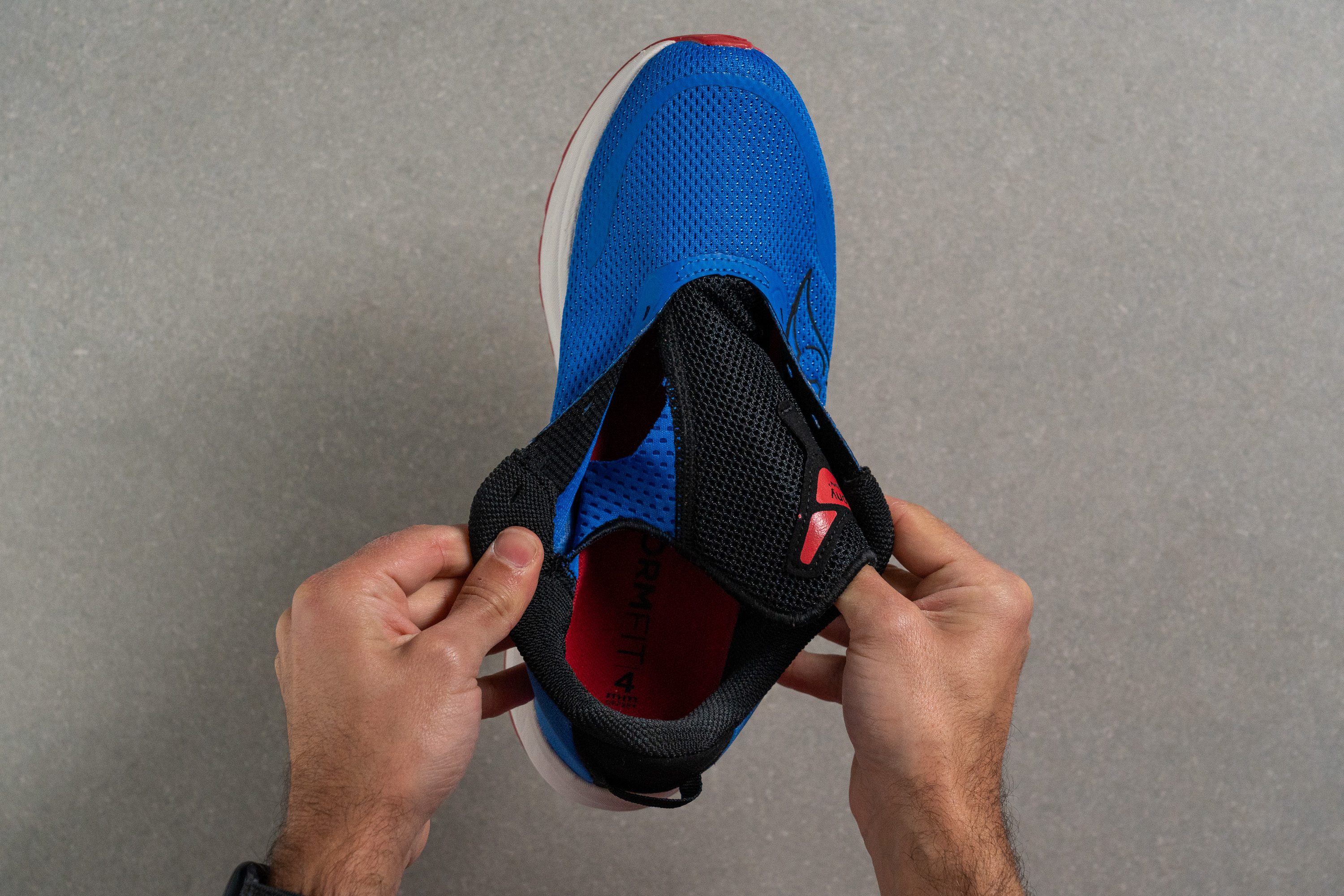
| Axon 3 | Both sides (semi) |
Heel tab
In the heel, there's a horizontal finger-loop heel tab. In our humble opinion, it doesn't look quite as good as the classic vertical ones, but it's definitely better than having none at all!
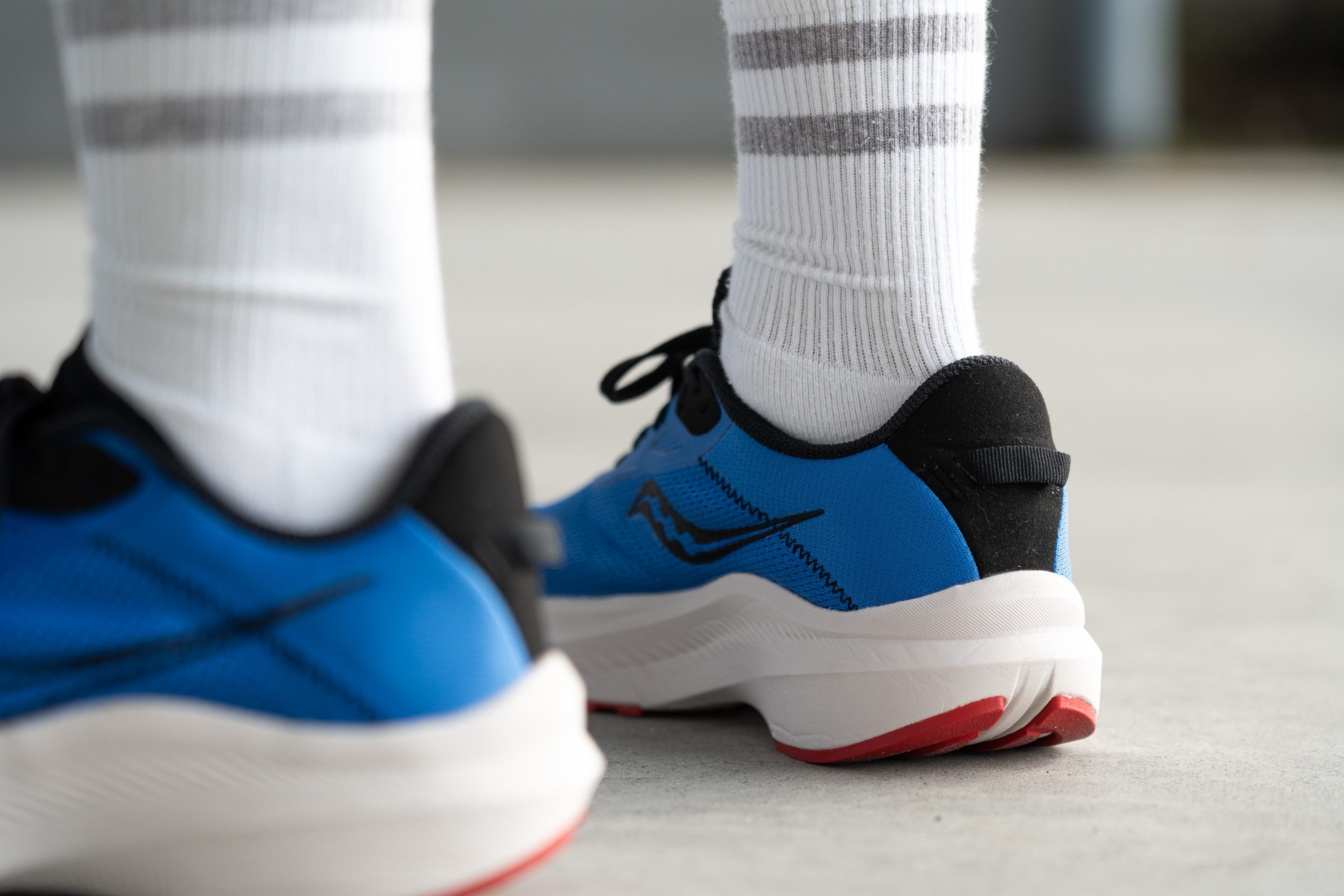
| Axon 3 | Finger loop |

